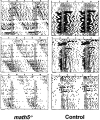Loss of photic entrainment and altered free-running circadian rhythms in math5-/- mice
- PMID: 12451142
- PMCID: PMC6758748
- DOI: 10.1523/JNEUROSCI.22-23-10427.2002
Loss of photic entrainment and altered free-running circadian rhythms in math5-/- mice
Abstract
Mammalian free-running circadian rhythms are entrained to the external light/dark cycle by photic signaling to the suprachiasmatic nuclei via the retinohypothalamic tract (RHT). We investigated the circadian entrainment and clock properties of math5-/- mutant mice. math5 is a critical regulator of retinal ganglion cell development; math5-/- mice show severe optic nerve hypoplasia. By anterograde cholera toxin B tracing, we find that math5-/- mice do not develop an identifiable RHT pathway. This appears to be attributable to agenesis or dysgenesis of the majority of RHT-projecting retinal ganglion cells. math5-/- mice display free-running circadian rhythms with a period approximately 1 hr longer than B6/129 controls (24.43 +/- 0.10 vs 23.62 +/- 0.19 hr; p < 0.00001). The free-running period of heterozygote mice is indistinguishable from that of controls. math5-/- mice show no entrainment to light/dark cycles, whereas heterozygote mice show normal entrainment to both 12 hr light/dark cycles and to a 1 hr skeletal photoperiod. math5-/- mice show reduced ability to entrain their rhythms to the nonphotic time cue of restricted running wheel access but demonstrate both free-running behavior and entrained anticipation of wheel unlocking in these conditions, suggesting the presence of a second diurnal oscillatory system in math5-/- animals. These results demonstrate that retinal ganglion cell input is not necessary for the development of a free-running circadian timekeeping system in the suprachiasmatic nucleus but is important for both photic entrainment and determination of the free-running period.
Figures






Similar articles
-
Loss of circadian photoentrainment and abnormal retinal electrophysiology in Math5 mutant mice.Invest Ophthalmol Vis Sci. 2005 Jul;46(7):2540-51. doi: 10.1167/iovs.04-1123. Invest Ophthalmol Vis Sci. 2005. PMID: 15980246 Free PMC article.
-
Advanced light-entrained activity onsets and restored free-running suprachiasmatic nucleus circadian rhythms in per2/dec mutant mice.Chronobiol Int. 2011 Nov;28(9):737-50. doi: 10.3109/07420528.2011.607374. Chronobiol Int. 2011. PMID: 22080784
-
Restricted wheel access following a light cycle inversion slows re-entrainment without internal desynchrony as measured in Per2Luc mice.Neuroscience. 2011 May 19;182:169-76. doi: 10.1016/j.neuroscience.2011.02.003. Epub 2011 Mar 12. Neuroscience. 2011. PMID: 21392557
-
Roles of PACAP-containing retinal ganglion cells in circadian timing.Int Rev Cytol. 2006;251:1-39. doi: 10.1016/S0074-7696(06)51001-0. Int Rev Cytol. 2006. PMID: 16939776 Review.
-
Photic regulation of clock systems.Methods Enzymol. 2015;552:125-43. doi: 10.1016/bs.mie.2014.10.018. Epub 2014 Dec 26. Methods Enzymol. 2015. PMID: 25707275 Review.
Cited by
-
The emerging roles of melanopsin in behavioral adaptation to light.Trends Mol Med. 2010 Oct;16(10):435-46. doi: 10.1016/j.molmed.2010.07.005. Epub 2010 Aug 31. Trends Mol Med. 2010. PMID: 20810319 Free PMC article. Review.
-
Development of melanopsin-based irradiance detecting circuitry.Neural Dev. 2011 Mar 18;6:8. doi: 10.1186/1749-8104-6-8. Neural Dev. 2011. PMID: 21418557 Free PMC article.
-
Mice deficient of glutamatergic signaling from intrinsically photosensitive retinal ganglion cells exhibit abnormal circadian photoentrainment.PLoS One. 2014 Oct 30;9(10):e111449. doi: 10.1371/journal.pone.0111449. eCollection 2014. PLoS One. 2014. PMID: 25357191 Free PMC article.
-
Math5 defines the ganglion cell competence state in a subpopulation of retinal progenitor cells exiting the cell cycle.Dev Biol. 2012 May 15;365(2):395-413. doi: 10.1016/j.ydbio.2012.03.006. Epub 2012 Mar 15. Dev Biol. 2012. PMID: 22445509 Free PMC article.
-
Atoh7-independent specification of retinal ganglion cell identity.Sci Adv. 2021 Mar 12;7(11):eabe4983. doi: 10.1126/sciadv.abe4983. Print 2021 Mar. Sci Adv. 2021. PMID: 33712461 Free PMC article.
References
-
- Abe H, Kida M, Tsuji K, Mano T. Feeding cycles entrain circadian rhythms of locomotor activity in CS mice but not in C57BL/6J mice. Physiol Behav. 1989;45:397–401. - PubMed
-
- Albrecht U, Zheng B, Larkin D, Sun ZS, Lee CC. MPer1 and mper2 are essential for normal resetting of the circadian clock. J Biol Rhythms. 2001;16:100–104. - PubMed
-
- Argamaso SM, Froehlich AC, McCall MA, Nevo E, Provencio I, Foster RG. Photopigments and circadian systems of vertebrates. Biophys Chem. 1995;56:3–11. - PubMed
-
- Asher JH., Jr Concerning the primary defect leading to the pleiotropic effects caused by anophthalmic white (Wh) in the Syrian hamster Mesocricetus auratus. J Exp Zool. 1981;217:159–169. - PubMed
Publication types
MeSH terms
Substances
Grants and funding
LinkOut - more resources
Full Text Sources
Other Literature Sources
Molecular Biology Databases
